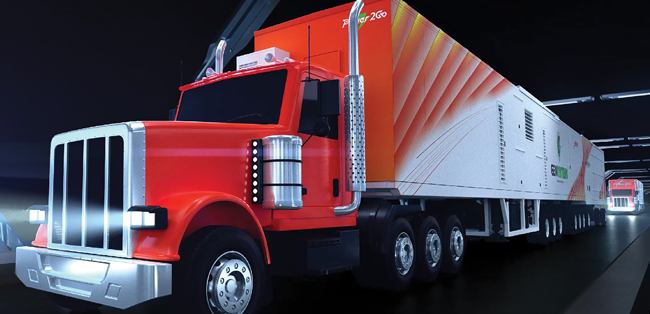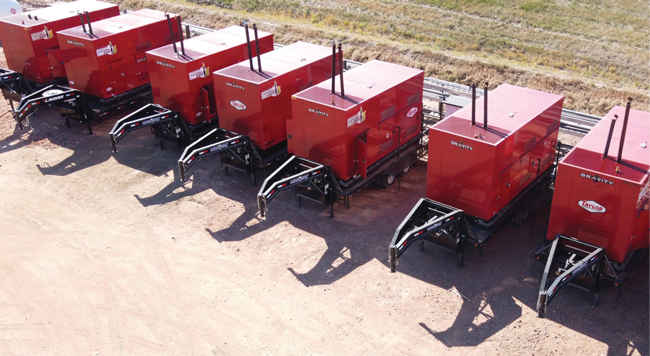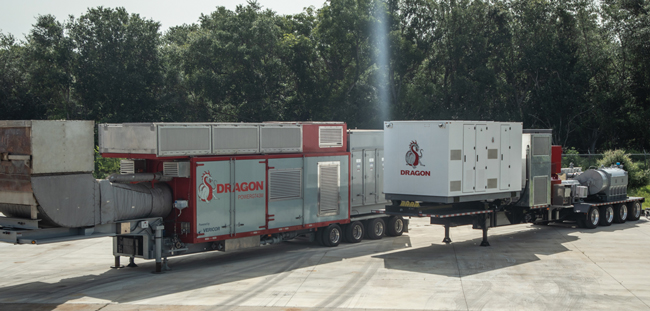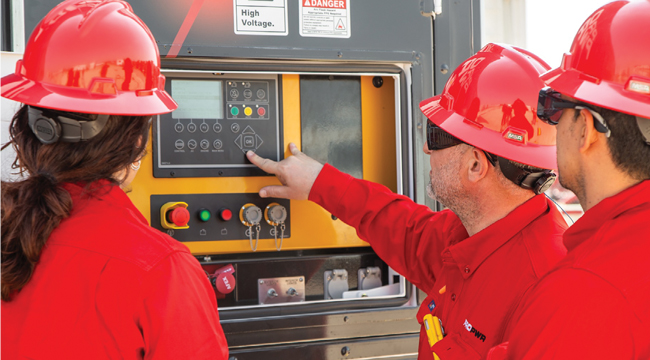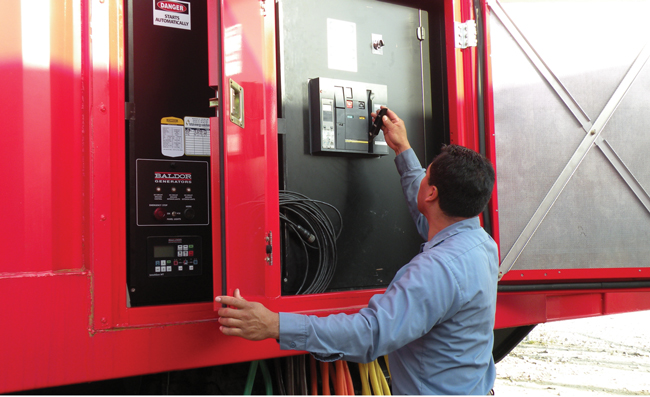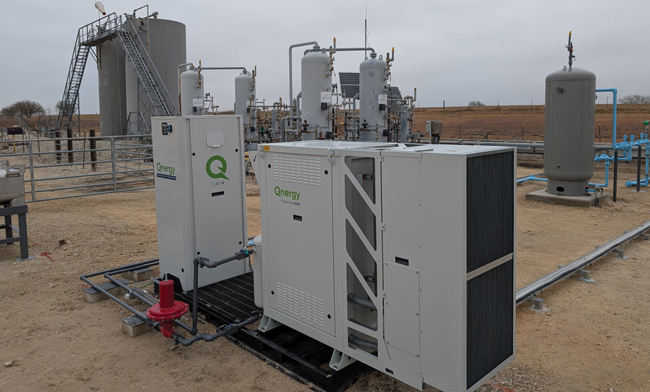
Power Demand Introduces Challenges
By Colter Cookson
According to the global accounting and advisory firm PwC, industries with high exposure to AI have seen the growth rate for employee productivity almost quadruple. From 2018-2022, it stood at 7%. But add in 2023 and 2024, when generative AI became widespread, and the number jumps to 27%.
That success story is behind the rush to build AI data centers, which have a voracious appetite for power. With utilities unable to keep pace, data centers, manufacturers and other major power consumers have turned to mobile power generators and microgrids to meet their needs.
The resulting surge in demand for generation equipment has pushed out lead times, particularly for large turbines generally used to power electric frac fleets, says Lyoid Fussell, president of GenSystems Power Solutions LLC. “The lead times for new turbines depend on the brand, but they are significant,” he reports. “If a company wants a 35-megawatt GE turbine, it is looking at delivery in 2030. The manufacturer Solar Turbines has shorter lead times, but they’re probably still two years out.”
With those long lead times, competition for existing assets has become fierce, Fussell reports. “It is becoming difficult for oil and gas to compete with data centers and other industrial projects,” he says. “In many cases, those projects can pay more and offer longer-term contracts.”
Initial contracts from data centers often fall in the 24-36 month range. With hydraulic fracturing activity down, Fussell contrasts, many oil and gas companies are looking for contracts that only last three-six months.
With time, competition should ease, Fussell assures. Many data centers and industrial users anticipate utilities eventually catching up to demand and for the time being are looking for bridge power, he notes. “In the conversations I have with data centers, people generally anticipate they will connect to the grid within five years,” he shares.
Even if utilities take longer than expected to meet data center demand, a real possibility, Fussell predicts turbine availability will go up as turbine suppliers increase manufacturing capacity. “They are trying to figure out the best sizes to focus on,” he remarks. “For a 300-megawatt facility, it may not make sense to supply a single 300-megawatt turbine, but two 150-megawatt units and maybe a spare could work. For smaller jobs, some companies are manufacturing 15-megawatt units.
“I anticipate that in the not-so-distant future, new turbine manufacturers will pop up,” he adds. “And I think plants that refurbish and rebuild turbines are going to become more prominent.”
There is no shortage of potential units to rebuild, Fussell assesses. “Gas turbines have been a primary source of energy since the 1950s, and unless a turbine’s main housing gets damaged, replacing the guts will essentially make it brand new.”
Legacy turbines will have to be upgraded to meet today’s emissions standards, but Fussell says selective catalytic converters should make that relatively easy. He indicates the bigger issue will be parts. “For the older turbines, parts have become scarce because there are so few of them still deployed,” he explains.
Technical Hurdles
As manufacturers work on expanding capacity, Fussell says packagers are grappling with two technical challenges. The first is emissions. “Some U.S. emission requirements may be lightened, but customers are going to continue to demand strong emissions controls,” he says.
With power demand rising far faster than grid capacity, interest in mobile turbines and other portable generators has intensified, GenSystems Power Solutions reports. The company says it is conducting research to shrink turbines’ already-low emissions and enhance their ability to adjust to sudden load drops.
Turbine nitrous oxide emissions can be reduced by modifying them to inject water alongside fuel, which requires a significant supply of distilled water and increases carbon monoxide emissions. Fussell says this is rarely the preferred path.
“Another solution is co-generation, which involves taking the turbines’ exhaust and using it to create more power,” Fussell says. “This reduces emissions for each megawatt produced, but it requires extra equipment, which can make the turbines less mobile.”
For mobile applications, Fussell says SCR will likely prove to be the most effective solution. “Today, these systems are not exactly inexpensive,” he acknowledges. “They are generally built into fixed plants, so there are not a lot of off-the-shelf solutions, and I’m not aware of any that work well for mobile applications or smaller turbines, such as ones that produce about 5.0 megawatts.”
Fussell says GenSystems has teams working on emissions solutions, including SCR systems tailored for mobile use.
“Aside from emissions, the second challenge turbine suppliers face is how to deal with sudden drops in load,” he says. “Data centers, especially ones that support AI, need a lot of power when they are being queried but much less once activity goes down. Some of the drops are equivalent to taking a couple frac pumps offline.
“When sudden drops happen, the fuel valves in the turbine cannot adjust fast enough to slow the speed of the turbine. It will spin too quickly for the load, then shut down to prevent any damage,” he outlines.
To address that risk, turbines need to connect to something that can absorb temporary excess power and turn sudden load drop into gradual ones. While it’s possible to use load banks to do so, Fussell advises against it because the banks typically convert power to heat rather than putting it to use. To rectify that, some companies leverage the power to mine bitcoin, he notes.
Instead of relying on load banks, Fussell recommends pairing turbines with batteries. “The idea is to feed the load to the turbine from the battery, because batteries can respond to load shifts with no issues,” he says. “The turbine charges the battery, and the battery delivers the power. With a properly sized battery, this can keep the turbine operating at its optimum load, which is usually between 80% and 100% of its capacity.”
This approach requires batteries capable of charging and discharging simultaneously, Fussell mentions. He says vanadium and flow cell-type batteries have the necessary flexibility.
Despite ongoing technological advances, both batteries and load banks tend to be too large and cumbersome for frac fleets. “The way we normally manage load shifts is to keep communication with the frac crews and make sure they drop one pump at a time and let us recover before dropping the next one,” he says. “When unforeseen issues happen, we end up needing to restart the turbines.”
In the best scenario, Fussell says drilling rigs, frac fleets and production equipment should be powered by operator-owned microgrids. “When a load is spread across a grid, load shedding events do not matter as much because there are many places for the power to go,” he explains. “Operators that want to continue down the electric completion path should consider building their own grid and producing power at a central facility rather than using mobile equipment that goes from site to site.”
That central facility would have the flexibility to adjust to demand changes across a field’s life, Fussell envisions. To accommodate the jump in power needs during hydraulic fracturing, it would have space for temporary generators. Once the field transitions to production, those generators could be relocated.
For microgrids to be economic, the field needs sufficient power demand, Fussell acknowledges. “If the ESPs, production facilities, plants and other equipment require 100 megawatts a day, investing in a microgrid should definitely be considered. Even at 50 megawatts, it might be worth looking at,” he estimates.
Microgrid Expansion
With utilities often unable to reach operators for two-four years, or in some cases indicating they will never be able to supply power, operators are taking matters into their own hands by renting generators, says Rob Rice, chief executive officer of Gravity Power & Rental “Coming into 2025, demand for natural gas generators was up 30%. That is the biggest increase we have seen in years,” he reports.
Despite growing power demand, careful planning has helped power-as-a-service companies retain some spare capacity. For smaller projects, Gravity Power & Rental says it can often start sending equipment to site within hours.
In late June, Rice mentioned that Gravity had seen demand pull back, a common occurrence at the start of summer. “It is too early to tell what will happen in the back half of the year, but the long-term outlook is strong,” he says. “The exact numbers vary from report to report, but there are hundreds of gigawatts of overall power demand coming in the next several years.
“We are beginning to see more microgrid applications,” he adds. “Our current largest generators typically output about 450 kilovolt amperes. For a microgrid, they’ll go through a transformer to step up to a higher voltage so the power can be dispersed across a wider area to handle the loads in the area. Those could be anything from electric compression to submersible pumps to gas plants.”
The less power a site requires, the shorter the lead times, Rice reports. “We have some idle capacity, so if an operator called asking for two megawatts, we could more than likely ship within hours,” he says. “For some larger jobs, we might need a week to get idle generators ready for service.”
For new equipment, the lead times still fall far short of those for utility power, Rice assures. He says new reciprocating generators in Gravity’s usual size range typically arrive in six-eight months. These generators can be connected together for applications that need significant power, he notes.
Recruiting and Retention
Labor continues to be a challenge, as it has been for the past several years, Rice comments. “In some areas, companies can expect to see annual turnover rates between 20% and 30%,” he says. “We are bringing new people into the industry and training them, but we have all had to become accustomed to the cycle and work hard on retention.”
Competitive wages and benefits alone are not enough. “When we talk with employees who have been with us less than two years, the biggest thing they say is that they want us to continue focusing on training. It’s not ‘I want to be paid more,’ ‘I want more vacation’ or ‘Can you change my hours?’ They want to advance their knowledge and build expertise so they can command higher pay and advance their careers.”
Noting that Gravity invests in training resources and online skill building, Rice describes training as beneficial to both the employee and the company. “For a power-as-a-service company, effective training means less downtime for our customers and lower operating costs for us,” he explains.
“This year, we upgraded to a new maintenance software that will be much easier for our technicians to use in the field,” he adds. “They can connect into the system with their phones and retrieve information that used to require calling the office and downloading a report. It’s much simpler to check a generator’s history and other factors that matter as we operate our fleet.”
As it is improving its internal tools, Gravity is building more convenient and informative customer dashboards, Rice continues. “The technology for retrieving, formatting and manipulating data has gotten so much better,” he marvels. “I’ve been in this business long enough to remember when a dashboard project would take more than a year because of how hard it was to pull data and program how it should be displayed. Today, it will only take a few months to pull in thousands of units and present the information in a user-friendly way.”
Rice says the new, more flexible dashboards will allow customers to quickly retrieve data on power loads, fuel usage and other parameters of interest.
As the demand for power grows, startups and established companies are entering the power-as-a-service space, Rice reports. He says those companies will only succeed if they involve people familiar with the specifics of oil and gas. “Power is one of the most significant reliability challenges operators face,” he says. “Any outage can have severe consequences, so operators want to work with companies who understand how much fuel quality varies and what that means for how equipment should be sized and maintained.”
Fuel Quality
For generator packagers, it’s rare for a day to pass without customers asking about emissions, reports Steve Stump, vice president of Dragon Power, a division of Dragon Products. “In New Mexico and California, meeting emission limits requires high-quality fuel and pretreatment equipment,” he says. “In some cases, we also add catalysts to reduce particulate matter.”
This 4.3-megawatt turbine from Dragon Power is one of many generators supporting electric hydraulic fracturing operations. In late June, the company indicated its lead times for such turbines are just six-nine months.
Because generators move from site to site, operators who have assets in several states often require new units to meet New Mexico’s standards even if the initial deployment will take place elsewhere, Stump mentions.
Over time, Stump says fuel conditioning equipment has improved. “That is good, because the purity of the fuel affects engine performance and run life,” he says. “If an engine or turbine will use fuel with contaminants, we have to shorten the performance life and recommend more maintenance.”
According to Stump, turbines can tolerate a wider range of fuels than reciprocating engines. “In the low range of Btu per cubic foot or gallon, the turbine will produce less power, but it will still run,” he notes. “It can also tolerate impurities, though technicians will have to change the filters more frequently.”
Turbines’ migration from power plants and aircraft into microgrid and portable power operations has been a boon for the oil and gas industry, Stump suggests. “Turbines require less maintenance than reciprocating engines, so in the right application, they can have noticeably lower operating costs,” he explains.
But turbines do have limitations. “They are meant to run, so they are perfect for applications where they can turn on and keep going for months. If they need to shut down and restart every 18 hours, recips may be a better fit,” Stump advises.
“The smaller the load, the more compatible recips becomes,” he adds. “Smaller turbines exist, but they are usually significantly more expensive than a recip with equivalent capacity.”
According to Stump, the lead times for turbines that produce 25 megawatts or more now extend beyond three years. “I’ve been in several industrial businesses, and three years is longer than buyers will tolerate,” he says. “The existing producers are working on additional capacity, because if they do not shorten lead times, new vendors will come into the market.”
In the meantime, Stump encourages power seekers to look for suppliers with spare capacity. “At Dragon, we have manufacturing capacity and equipment from other product lines that we can repurpose if power generator demand justifies it,” he says. “That has helped us keep lead times short.”
Below a megawatt, the company’s lead times are around six months. For one megawatt to 2.5 megawatts, they go to six months. For a 4.3-megawatt turbine, the range is around six-to-nine months, Stump outlined in late June.
As demand for power generation rises, Stump predicts that generators will become more specialized. “We may see models that are designed for specific applications, such as bitcoin mining,” he says.
Diverse Demand
By 2029, some analysts estimate that data centers alone will increase power demand by 72-130 gigawatts, says Dave Bosco, vice president of PROPWR, a division of ProPetro. Meanwhile, manufacturers are attempting to reshore production for microchips and other products that require energy-intensive automation to produce with the necessary precision. And U.S. citizens are relocating from California and the Northeast to the Southwest, contributing to growing demand there.
Because utility power is often years away, if it’s available at all, sites increasingly get power from microgrids supported by long-term contracts rather than month-to-month or year-to-year rentals. With the right rate structure, PROPWR says such contracts can protect operators from volatility in the broader power market and provide more predictable input costs.
These trends are driving electricity costs up, Bosco assesses. “The forward curve on electricity prices suggests we are entering an expensive market,” he warns. “Some models predict we could end up like Europe, where it costs 30 or 40 cents a kilowatt hour for consumers instead of 15.”
Whether or not the more pessimistic predictions take place, the need for power is clear. Bosco says the trend is inspiring formation of companies that provide power as a service to data centers, industrial clients, and oil and gas, among other sectors.
PROPWR, which grew out of ProPetro’s experience powering electric frac fleets, plans to focus initially on supplying the oil and gas industry with reliable but affordable power, Bosco describes. He says the company works to offer turnkey service and a utility-like experience. In other words, when operators flip the light switch, power is there, and it will be reliable.
“When folks start a power-as-a-service business, it can be tempting to scale up by buying whatever generators are available,” he says. “However, we were very surgical with picking the assets we wanted to have in our fleet, because we wanted to standardize. Think of Southwest Airlines, which can keep its costs low because it has one flavor of airplane and knows that airplane extremely well.”
Oil field power generation requires a more diverse fleet, but it still benefits from standardization. In selecting its solutions for each application, Bosco says PROPWR sought units with low emissions, high efficiency and the potential for upgrades as technology evolved or needs changed. By pairing these high-quality generators with data analytics, he says the company aims to control its costs and provide long-term stable rate structures for partners/customers.
To optimize maintenance on the generators’ prime movers, PROPWR partners with engine and turbine suppliers. “We could be arrogant and say that our team of mechanics can figure out how to work on a turbine made by Solar Turbines better than Solar or on a Caterpillar engine better than Cat, but the OEMs know their equipment. By aligning with them to maintain our prime movers the right way, we can achieve high availability and reliability.”
These partnerships let the company’s internal teams focus on other components of the package, balance of plant, electrical systems and control systems. “Each of our assets has an edge device that collects and transmits information for analysis by algorithms and expert teams providing 24/7/365 remote monitoring and support,” he says. “Those teams use historical analysis and our understanding of how other components impact equipment reliability to proactively plan and schedule maintenance, based on the equipment’s condition, not simply its run hours.”
Long-Term View
While mobile equipment can get projects started, Bosco says stationary generators are better suited for long-term power due to their more appealing reliability and availability profiles.
Given utilities’ capacity constraints and long lead times, Bosco says it often makes sense for service providers and power seekers to eschew the traditional month-to-month or year-to-year rental contracts in favor of long-term partnerships that support investments in equipment and closer collaboration. As a case in point, he indicates that PROPWR’s first contract has a 10-year term.
“We want to work with customers on optimizing the sites and in-field distribution to provide resilient power and drive down lease operating expenses,” he says.
Bosco adds that the company aims to align power delivery with customer needs. For example, service level agreements guarantee availability and reliability of power, much like what operators would expect from a utility.
To keep costs as predictable as possible, the company tries to link the rate structure to the work product of interest. “If we are in a microgrid installation that supports a producing field, that might be the oil and gas coming out of the ground,” he illustrates.
Bosco compares such long-term, output-oriented contracts to hedges. “As an industry, whether we are in a period of feast or famine, the contracts provide stable and predictable rates that insulate operators from broader market volatility,” he states.
Achieving that predictability requires patience, Bosco emphasizes. “Getting dependable and affordable power is 90% planning and 10% execution,” he says. “This is one domain where slow is fast. If we want 99.999% reliability, we cannot afford to sign a contract, run out the next day, and figure everything out on the fly. Front-end engineering and design is imperative to ensure the system has the redundancy and efficiency to meet the operator’s needs.”
Continuous Improvement
Generators may already be able to achieve uptimes beyond 99%, but that has not kept suppliers from looking for ways to make the equipment even more reliable, says Chad Elliston, manager of Total Energy Solutions. “Power generation is like any other industry. Any company that is not improving is going backwards,” he comments.
As microgrids proliferate, so has the need for technicians who understand both electrical and mechanical systems. Power companies such as Total Energy Solutions say they frequently recruit people from outside the industry, including many veterans, and train them internally.
That penchant for progress extends to the engine manufacturers that partner with TES, Elliston says. He mentions that one of its suppliers is about to introduce a new engine platform. “This platform will pack a bit more power in the same footprint. It will also address issues with certain engine components that lead to downtime, which means the reliability should be even greater than existing generator engines,” he enthuses.
“We have positioned ourselves to purchase all the production in 2025 and 2026 for this engine platform,” he reports. “That will help us keep up with demand from the oil and gas industry and other sectors.”
Even with the best components, Elliston says generators still need maintenance from skilled technicians. In general, he recommends servicing equipment every 750 hours, which is about once a month.
“Generator technicians have a unique skill set,” he comments. “They are not just mechanics or just electricians. To work on generators, they have to understand the four main components: the engine, the generator that converts the engine’s output into electricity, the controller, and the housing that protects everything. The technicians often work in the middle of nowhere, and if a generator goes down unexpectedly, it’s likely someone will be tapping their foot nearby, because they need power back up fast.”
That broad skillset is rare enough that Elliston says TES trains most of its technicians through in-house apprenticeships and mentoring programs. “Most of our people are referrals from our existing workforce,” he says. “I’m very proud that we hire a lot of veterans.”
As microgrids become more common, Elliston says the company frequently works with operators to optimize them. “For safety, the equipment and fuel sources need to have the correct spacing between them,” he notes. “Technicians need access to the equipment, and the grid has to have enough redundancy they can take a generator offline for service without disrupting the site’s operations.”
As a rule of thumb, Elliston says the grid should be set up so that most of the generators are operating at 70%-75% load. In that window, they use fuel efficiently and minimize wear and tear, he explains.
Microgrid performance depends on more than generators. “When we are building microgrids, we need equipment that can tie 20 generators together to produce a common output, then distribute that power to the equipment that needs it,” Elliston illustrates.
TES gets its generator parallelization and power distribution equipment from Power Temp Systems, a sister company that has been in business for 35 years. “The level of safety Power Temp puts in place is remarkable,” Elliston says. “When our technicians need to isolate a piece of equipment to service or move it, we have breaker protection in line and do not have to worry about catastrophic issues to people or equipment.”
Maintenance-Free Engine
The modern incarnation of a concept originally patented in 1816 has proven extremely effective at providing affordable power in remote locations, says Ory Zik, chief executive officer at Qnergy. He explains that the free-piston Stirling-cycle engine requires almost no maintenance because most of the work is done inside a sealed container.
Many operators now rely on Stirling cycle engines to generate power for remote equipment, including air compressors that allow sites to actuate pneumatic valves with air rather than gas. Stirling engine developer Qnergy attributes this growth to the engines’ maintenance-free design and low operating costs.
“This sealed enclosure contains helium. To generate power, the system applies heat from outside the container, which causes the helium to expand and push a displacer connected to a piston,” he describes. “As the piston moves, a fixed magnet interacts with stators to produce electricity.”
This process repeats as the helium cools, then expands, Zik continues. “It is very reliable,” he says. “There are no rotating parts, so there is almost no wear and tear and no need for lubrication. That lets the engine run for years without any maintenance.
“The engine itself is designed for almost 10 years of continuous operation without any maintenance,” he clarifies. “However, it is within a generator, and that generator has electronics that could fail and a radiator that needs to be cleaned, so we do send service techs to site at least once a year to clean the radiator and replace some components.”
To heat the helium, Qnergy’s generators combust methane. In the process, the burner destroys 99.99% of the gas, Zik reports.
“The burner can create sufficient heat even with low-grade, unrefined methane, so the free-piston Stirling generator is very useful on well pads and other sites that have access to field gas,” he says.
According to Zik, one of the most popular applications targets emissions from pneumatic valves. By using the generator to power air compressors, operators can actuate gas-operated valves with air rather than methane, a change that Zik mentions can help sites comply with the emissions guidelines in OOOOc.
“Another application is vapor recovery. The generator can run on methane concentrations as low as 30%, so operators can use it to turn the vapors from oil and water tanks into electricity,” Zik says.
The Stirling generator costs slightly more than traditional alternatives, but Zik says the benefits make up for that. “In methane abatement applications, how quickly the generator pays for itself depends on the value the operator assigns to the gas,” he says. “If gas is $3 per million Btu, the gas savings usually cover the system’s cost within six months.”
But even in areas where gas has limited value, such as the Permian Basin, the economics can be attractive. “Over two years, the maintenance savings alone will break even. Beyond that, the Stirling generator will be cheaper,” Zik calculates.
When the company first commercialized the technology, Zik acknowledges, it faced skepticism from engineers who associated Stirling engines with toys for kids rather than industrial applications. He says Qnergy has succeeded at expanding the technology’s scope through decades of research.
“Qnergy started in the 80s to support NASA, which wanted an energy source for areas of space without solar radiation,” he relates. “A Stirling engine made a lot of sense for these applications, so we received considerable funding throughout the 80s and 90s, particularly from NASA and the Department of Energy.”
The sustained and concentrated R&D effort has allowed the company to overcome difficult challenges. “For example, the heat exchanger that transfers the heat to the enclosed chamber has more than 300 laser welds that could allow the helium to leak if they are done improperly,” he says. “Getting those welds right is extremely complex, but we managed to do so.”
Today, Zik reports, more than 3,000 Qnergy free-piston Stirling engines have been deployed in the United States alone, with the first ones operating continuously since the company’s commercial launch in 2018. Their users include independents such as Antero Resources, EQT, Hilcorp and Range Resources, majors such as BP, ConcoPhillips, Shell and TotalEnergies, and midstream firms such as Equitrans Midstream, Kinder Morgan, and Williams.
For other great articles about exploration, drilling, completions and production, subscribe to The American Oil & Gas Reporter and bookmark www.aogr.com.







